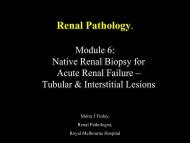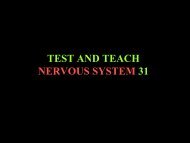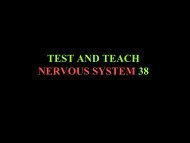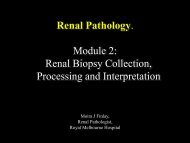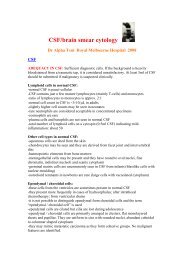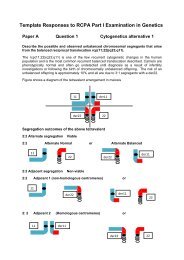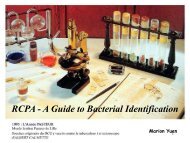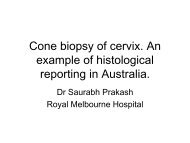Clinical Applications of Mass Spectrometry - RCPA
Clinical Applications of Mass Spectrometry - RCPA
Clinical Applications of Mass Spectrometry - RCPA
You also want an ePaper? Increase the reach of your titles
YUMPU automatically turns print PDFs into web optimized ePapers that Google loves.
<strong>Mass</strong> spectrometry<br />
1.Principles and<br />
2.<strong>Clinical</strong> <strong>Applications</strong><br />
Pr<strong>of</strong> F G Bowling<br />
Director <strong>of</strong> Biochemical Diseases<br />
Mater Children’s Hospital<br />
Brisbane, AUSTRALIA
Overview<br />
‣ <strong>Mass</strong> spectrometry is an analytical technique that identifies the chemical composition <strong>of</strong> a<br />
compound or sample based on the mass-to-charge ratio <strong>of</strong> charged particles.<br />
‣ A sample undergoes chemical fragmentation, thereby forming charged particles (ions). The ratio <strong>of</strong><br />
charge to mass <strong>of</strong> the particles is calculated by passing them through electric and magnetic fields in<br />
a mass spectrometer.<br />
‣ The design <strong>of</strong> a mass spectrometer has three essential modules:<br />
• an ion source, which transforms the molecules in a sample into ionized fragments;<br />
• a mass analyzer, which sorts the ions by their masses by applying electric and magnetic fields; and<br />
• a detector, which measures the value <strong>of</strong> some indicator quantity and thus provides data for calculating the<br />
abundances <strong>of</strong> each ion fragment present.<br />
‣ The technique has both qualitative and quantitative uses, such as<br />
• identifying unknown compounds,<br />
• determining the isotopic composition <strong>of</strong> elements in a compound,<br />
• determining the structure <strong>of</strong> a compound by observing its fragmentation, quantifying the amount <strong>of</strong> a<br />
compound in a sample,<br />
• studying the fundamentals <strong>of</strong> gas phase ion chemistry (the chemistry <strong>of</strong> ions and neutrals in a vacuum), and<br />
• determining other physical, chemical, or biological properties <strong>of</strong> compounds<br />
‣ The technology is frequently used as the definitive method for molecules analysed routinely by<br />
other methods in Pathology Laboratories, but<br />
‣ Because <strong>of</strong> advances in technology it is now replacing many <strong>of</strong> those older methods in routine use.<br />
2
1.Principles<br />
<strong>Mass</strong> spectrometry<br />
‣ method for determining the mass <strong>of</strong> molecules<br />
by producing and analysing charged species<br />
‣ measures the mass to charge ratio (m/z) <strong>of</strong> ions.<br />
‣ USES:<br />
• analyser:<br />
•To identify unknown molecules,<br />
•To elucidate structure & chemical<br />
properties<br />
• detector:<br />
•To quantify known materials<br />
3
‣ <strong>Mass</strong> Spectrometer<br />
• INLET SYSTEM<br />
MS Instrumentation<br />
• ION SOURCE: form gas-phase ions from sample,<br />
• ANALYSER: separate ions based on their mass-to-charge<br />
ratio (m/z),<br />
• DETECTOR: measure the abundance <strong>of</strong> the ions according<br />
to m/z.<br />
• DATA OUTPUT: mass spectrum<br />
Relative abundance<br />
m/z<br />
4
Ionisation<br />
‣ Molecules gain or lose electrons such that they acquire a<br />
positive or negative charge<br />
‣ ionisation process can produce<br />
• molecular ion: same molecular weight and elemental<br />
composition <strong>of</strong> the starting analyte<br />
• fragment ion: corresponds to smaller piece <strong>of</strong> the analyte<br />
molecule<br />
‣ Common molecular ion products <strong>of</strong> ionisation<br />
• Molecular ions M + or M -<br />
• Protonated molecules [M + H] +<br />
• Simple adduct ions [M + Na] +<br />
‣ Different ionisation techniques depending on chemical &<br />
physical properties <strong>of</strong> molecule <strong>of</strong> interest<br />
5
Electron Ionisation (EI)<br />
‣ Suitable for volatile organic compounds<br />
‣ Gaseous sample molecules bombarded with<br />
beam <strong>of</strong> energetic electrons<br />
‣ Results in loss <strong>of</strong> electrons from sample,<br />
formation <strong>of</strong> radical cation<br />
• M + e - M +· + 2e -<br />
‣ EI mass spectra contain intense fragment ion<br />
peaks and much less intense molecular ion peaks<br />
6
Chemical Ionisation (CI)<br />
‣ suitable for volatile, more polar compounds<br />
‣ excess <strong>of</strong> reagent gas is firstly ionised by EI, then<br />
introduced to sample<br />
‣ ion molecule reactions occur between ionised<br />
reagent gas molecules and volatile analyte<br />
neutral molecules to produce analyte ions.<br />
‣ Pseudo-molecular ion MH + (positive ion mode)<br />
or [M-H] - (negative ion mode) + few fragment<br />
ions produced<br />
‣ main reagent gases used: Ammonia, Methane,<br />
and Isobutane<br />
7
Fast Atom Bombardment (FAB)<br />
‣ Used for large compounds with low volatility (eg peptides,<br />
proteins, carbohydrates)<br />
‣ sample mixed with a non-volatile matrix and attached to end <strong>of</strong><br />
probe<br />
‣ bombarded with fast beam <strong>of</strong><br />
atoms (neutral inert gas Ar/Xe)<br />
‣ Sample molecules ejected from<br />
matrix, ionised and extracted<br />
into the mass analyser<br />
‣ produces [M+H] + & [M+Na] +<br />
ions<br />
8
Electrospray Ionisation (ESI)<br />
‣ S<strong>of</strong>t ionisation technique suitable for proteins, peptides,<br />
oligonucleotides<br />
‣ Type <strong>of</strong> atmospheric pressure ionisation<br />
‣ Generates mainly multiply charged ions directly from solution<br />
‣ Liquid (solvent + analyte mixture) passed through fine stainless<br />
steel capillary into chamber at atm pressure in presence <strong>of</strong><br />
strong electrostatic field & heated drying gas<br />
‣ Emerging solution dispersed into fine spray <strong>of</strong> charged<br />
droplets all at same polarity<br />
9
Electrospray Ionisation (ESI)<br />
‣ Solvent evaporates away, shrinking droplet size, increasing<br />
charge concentration at droplet’s surface<br />
‣ Droplets explode once charge repulsion overcomes surface<br />
tension<br />
‣ shrinking and explosion continues until individually charged<br />
‘naked’ analyte ions formed.<br />
10
Matrix Assisted Laser Desorption/Ionisation<br />
(MALDI)<br />
‣ analyte co-crystallised with excess <strong>of</strong> matrix compound on<br />
MALDI target<br />
‣ Inserted into MS under high vacuum<br />
‣ Pulsed laser beam (nitrogen UV laser) directed at<br />
matrix/sample spot<br />
‣ Laser energy absorbed by matrix, transferred to analyte<br />
‣ Matrix/analyte desorbed from<br />
surface & ionised<br />
‣ Results in mainly singly charged<br />
ions [M+H] + or [M+Na] + in<br />
positive ion mode<br />
‣ Electric field applied between<br />
sample and extraction grid to<br />
accelerate ions<br />
11
Matrix Assisted Laser Desorption/Ionisation<br />
MATRICES<br />
‣ Nature <strong>of</strong> matrix highly important in MALDI experiment<br />
‣ Functions <strong>of</strong> matrix<br />
• Dilute sample and isolate sample molecules from each other<br />
• Absorb laser light energy and indirectly cause analyte to vaporize.<br />
• Ionise analyte by serving as proton donor or receptor, in both positive<br />
and negative ionisation modes, respectively.<br />
‣ Mostly crystalline compounds<br />
‣ Examples <strong>of</strong> common matrices:<br />
Sinapinic acid<br />
2,5-dihydroxybenzoic<br />
acid<br />
3-Hydroxypicolinic<br />
acid<br />
6-aza-2-thiathymine<br />
large proteins<br />
glycoproteins<br />
proteins<br />
carbohydrates<br />
oligonucleotides<br />
glycoproteins<br />
12
Surface-Enhanced Laser Desorption<br />
Ionisation (SELDI)<br />
‣ Target modified to capture molecule <strong>of</strong> interest within sample<br />
mixture attach antibodies, lectins, DNA<br />
‣ Functions as solid-phase extraction technique<br />
‣ Unbound fragments washed away prior to ionisation<br />
‣ Matrix solution added to enhance laser energy transfer &<br />
analyte ionisation<br />
‣ Laser desorption/ionisation followed by TOF MS<br />
13
<strong>Mass</strong> analysers<br />
‣ Separates the ions generated in ion source<br />
according to mass/charge ratio<br />
‣ Can combine 2 or more analysers in tandem MS<br />
systems<br />
‣ Different types:<br />
• Magnetic sector<br />
• Time-<strong>of</strong>-flight<br />
• Quadrupole<br />
• Ion trap<br />
• Fourier-transform ion cyclotron resonance<br />
14
Time <strong>of</strong> Flight (TOF) analysers<br />
‣ Simplest type <strong>of</strong> mass analyser<br />
‣ virtually unlimited mass range<br />
‣ higher masses lower resolution<br />
‣ potential applied across ion source to extract and accelerate<br />
ions into field-free ‘drift’ zone<br />
‣ ideally ions <strong>of</strong> same mass/charge will have same kinetic energy<br />
‣ time <strong>of</strong> arrival at detector relates to mass <strong>of</strong> ion<br />
‣ the lower the ion's mass, the greater the velocity and shorter its<br />
flight time.<br />
Source, s<br />
Field-free drift zone, d<br />
Detector<br />
Es = Vs/ls<br />
length = ls<br />
Vs<br />
length = ld<br />
15
Reflectron TOF<br />
‣ Reflecting & decelerating fields at end <strong>of</strong> flight tube<br />
‣ Compensate for difference in flight times <strong>of</strong> same m/z ions with<br />
slightly different kinetic energies<br />
‣ Higher kinetic energy ions penetrate decelerating field further<br />
than ions with lower kinetic energy<br />
‣ Slow ions ‘catch up’ to fast ions <strong>of</strong> same m/z<br />
‣ Decrease spread <strong>of</strong> ion flight times improve resolution<br />
16
Delayed extraction TOF<br />
‣ Delayed extraction in linear mode also used to improve<br />
resolution<br />
‣ Delayed-extraction grid located between the sample target and<br />
the drift-tube entrance grid.<br />
‣ Ions allowed to spread out before the voltage is applied to<br />
accelerate them into the flight tube.<br />
‣ Time delay typically 5 to 20 microseconds<br />
‣ When the delayed extraction voltage is finally turned on, the<br />
lower-velocity ions experience a greater accelerating voltage<br />
than the higher-velocity ions<br />
‣ This reduces the energy spread between molecules that have<br />
the same m/z ratio and therefore reduces peak broadening.<br />
17
Quadrupole (Q) analyser<br />
‣ Four parallel rods with fixed DC & alternating Rf voltages<br />
arranged in a square<br />
‣ Analyte ions directed down centre <strong>of</strong> square<br />
‣ By varying strengths and frequencies <strong>of</strong> magnetic fields, change<br />
defined m/z value that will pass through<br />
‣ Upper limit <strong>of</strong> mass range is<br />
m/z 2200-3000<br />
‣ May operate in two modes:<br />
• Scanning mode<br />
monitoring range <strong>of</strong> m/z ratios<br />
• Selected ion monitoring mode<br />
monitoring selected m/z ratios<br />
18
Ion trap analyser<br />
‣ Consist <strong>of</strong> 3 electrodes forming a chamber<br />
• Ring electrode<br />
• Entrance endcap electrode<br />
• Exit endcap electrode<br />
‣ Ions entering chamber ‘trapped’ by electromagnetic fields<br />
‣ Various voltages applied to trap and eject ions according<br />
to m/z values<br />
19
Triple Quad (Tandem) MS (MS/MS)<br />
‣ Powerful way to obtain structural information<br />
‣ Common example: triple quadrupole<br />
‣ First quadrupole used to select precursor ion<br />
‣ Second quadrupole (Rf only) used as a collision cell for<br />
fragmentation <strong>of</strong> precursor ion (collision induced<br />
dissociation; collision with inert gas)<br />
‣ Third quadrupole generates spectrum <strong>of</strong> resulting product<br />
ions<br />
‣ May use TOF analyser in place <strong>of</strong> third quadrupole<br />
20
2. <strong>Clinical</strong> <strong>Applications</strong><br />
24
Quantitation <strong>of</strong> small molecules<br />
‣ Molecules<br />
• Aminoacids<br />
• Intermediate metabolites<br />
• (Organic acids and<br />
Acylcarnitines)<br />
• Neurotransmitters<br />
• Steroids<br />
‣ Technology<br />
• GC-MS<br />
• LC-MS<br />
• Triple Quad<br />
• Ion Trap<br />
• TOF<br />
• Cytokines<br />
• Xenobiotic (metabolites)<br />
• Vitamins<br />
25
Quantition <strong>of</strong> peptides<br />
‣ Molecule<br />
• Glycoprotein<br />
hormones<br />
• Immunoglobulins<br />
• Protein digests<br />
‣ Technology<br />
• LC -- Ion Trap<br />
• LC – Triple Quad<br />
• LC -- TOF<br />
• (MALDI-TOF)<br />
26
Identification / Quantitation proteins<br />
‣ Molecule<br />
• Glycosylated<br />
Haemoglobin<br />
• Enzymes<br />
• Troponin and other<br />
structural<br />
‣ Technology<br />
• Peptide digest<br />
• LC or Gel fractionation<br />
• Ion Trap<br />
• MALDI<br />
• TOF<br />
‣ Analysis<br />
• Protein databases<br />
• eg MASCOT <br />
27
Identification Micro-organisms<br />
‣ Molecule<br />
• Membrane proteins<br />
• Cell wall glycoproteins<br />
• Surface lipoproteins<br />
• Cytosolic enzymes<br />
‣ <strong>Clinical</strong><br />
• Bacteria<br />
• Viruses<br />
• Protozoa<br />
‣ Technology<br />
• MALDI-TOF<br />
‣ Comment<br />
• Proteomic analysis<br />
performed on isolated<br />
organisms<br />
• Biological fluid<br />
techniques in<br />
development<br />
28
Tissue Imaging<br />
‣ Molecule<br />
• Pathological markers<br />
• Tissue specific proteins<br />
• Tumour markers<br />
• Acute response<br />
• Apoptosis<br />
‣ Technology<br />
• MALDI Imaging <strong>of</strong><br />
• fresh tissue sections<br />
• fixed tissue sections<br />
• including slides<br />
29





